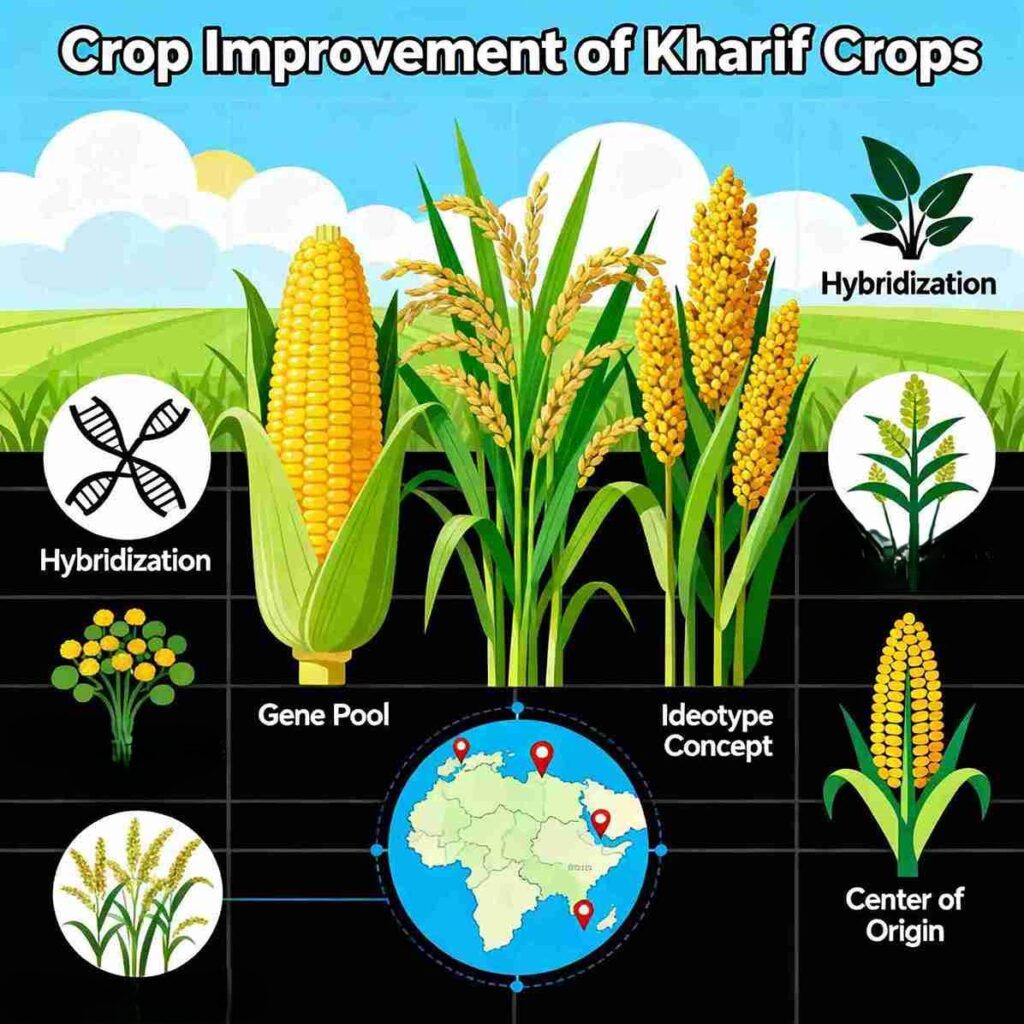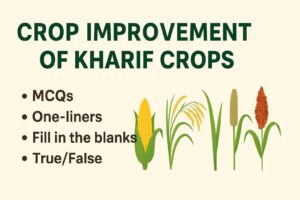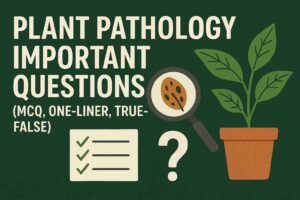
Author–Kumesh choudhari
For every agriculture student, understanding the BSc Agriculture Crop Improvement of Kharif Crops is both exciting and challenging. Subjects such as ideotype, germplasm, gene pool, hybridisation, and concepts of centre of origin or isolation distance often appear scattered in books. During exam time, it becomes challenging to revise them all together.
That’s why I created this post, where you will find everything in one place — from the basics of major crops like Maize, Rice, Pearl Millet, and Sorghum (their botanical name, family, first hybrid, and isolation distance) to the hybridization concepts that are most important for exams.
Along with notes, this page also includes MCQs, one-liners, fill-in-the-blanks, true/false, and key terminologies, so that you can practice in every format and prepare with confidence. Whether you are studying for BSc Agriculture semester exams, ICAR-JRF, or any competitive exam, this guide will save your time and make revision easier.
👉 So, if you are searching for a clear and exam-oriented resource on Crop Improvement of Kharif Crops, this post will be your perfect study companion.
True/False, and One-liners so that you can practice and revise more effectively.
👉 If you are looking for a complete, exam-focused collection of BSc Agriculture Plant Pathology MCQ and related questions, then this post will definitely help you.
Top 40 BSc Agriculture Crop Improvement of Kharif Crops (MCQs)
Section A: Conceptual Topics (Ideotype, Germplasm, Gene pool)
The term “Crop Ideotype” was first proposed by:
a) Norman Borlaug
b) Donald (1968)
c) Swaminathan
d) Mendel
Answer: b) Donald (1968)The purpose of an ideotype breeding programme is:
a) Increase input requirement
b) Genetic uniformity
c) Higher yield with desirable traits
d) Disease susceptibility
Answer: c) Higher yield with desirable traitsGermplasm is:
a) Collection of seeds of only wild plants
b) Total genetic resources of a crop species
c) Only hybrids and varieties
d) Only mutants
Answer: b) Total genetic resources of a crop speciesNarrow gene pool includes:
a) Only cultivated varieties
b) Wild relatives only
c) Exotic material exclusively
d) All species of a family
Answer: a) Only cultivated varietiesPrimary gene pool refers to:
a) Interfertile forms with cultivated species
b) Species with partial fertility
c) Interspecific crosses with difficulty
d) Experimental hybrids of unrelated crops
Answer: a) Interfertile forms with cultivated speciesSecondary gene pool includes:
a) Members that cross freely with crop
b) Species showing partial fertility with crop
c) Mutants of the crop
d) Microbial species
Answer: b) Species showing partial fertility with cropTertiary gene pool members produce:
a) Fully fertile progeny
b) Partially fertile progeny
c) Highly sterile progeny requiring special techniques
d) Apomictic hybrids
Answer: c) Highly sterile progeny requiring special techniquesIn germplasm conservation, gene banks mainly conserve:
a) Soil microbes
b) Seeds, pollen, tissues
c) Animal embryos
d) Only exotic species
Answer: b) Seeds, pollen, tissues
Section B: Maize – Basics, Hybridization, Center of Origin
- Scientific name of maize is:
a) Sorghum bicolor
b) Oryza sativa
c) Pennisetum glaucum
d) Zea mays
Answer: d) Zea mays - Family of maize is:
a) Solanaceae
b) Poaceae
c) Fabaceae
d) Cruciferae
Answer: b) Poaceae - Maize originated in:
a) India
b) Mexico and Central America
c) Africa
d) Southeast Asia
Answer: b) Mexico and Central America - First high yielding maize hybrid in India released was:
a) Ganga-1
b) Deccan Hybrid
c) Double cross hybrid – Ganga Safed-2
d) Ganga-5
Answer: a) Ganga-1 - Isolation distance for maize hybrid seed production is:
a) 200 m
b) 300 m
c) 400 m
d) 500 m
Answer: c) 400 m - Maize is a cross-pollinated crop with pollination type:
a) Cleistogamous
b) Geitonogamy (mostly wind pollination)
c) Autogamy
d) Entomophily
Answer: b) Geitonogamy - Hybrid seed production in maize is successful due to:
a) Protogyny
b) Protandry
c) Apomixis
d) Vegetative propagation
Answer: b) Protandry - Normal hybridization technique used in maize is:
a) Hand emasculation + pollination
b) Detasseling and controlled pollination
c) Emasculation by chemical agents
d) None
Answer: b) Detasseling and controlled pollination
Section C: Rice – Basics, Hybridization, Center of Origin
- Scientific name of rice is:
a) Oryza sativa
b) Zea mays
c) Triticum aestivum
d) Sorghum bicolor
Answer: a) Oryza sativa - Rice belongs to family:
a) Poaceae
b) Fabaceae
c) Cucurbitaceae
d) Brassicaceae
Answer: a) Poaceae - Center of origin of rice is considered to be:
a) Mexico
b) Indo-Burma and Southeast Asia
c) Africa
d) Europe
Answer: b) Indo-Burma and Southeast Asia - First high yielding rice variety in India was:
a) Jaya
b) IR-8
c) Taichung Native 1
d) Pusa Basmati
Answer: b) IR-8 - In India, first rice hybrid released was:
a) APHR-1
b) KRH-1
c) Pusa RH-10
d) IR-64
Answer: b) KRH-1 - Isolation distance for rice hybrid seed production is about:
a) 100 m
b) 200 m
c) 250 m
d) 400 m
Answer: b) 200 m - Hybrid seed production in rice is largely based on:
a) Self-incompatibility
b) Cytoplasmic genetic male sterility (CMS) system
c) Apomixis
d) Protandry
Answer: b) CMS system
Section D: Pearl Millet – Basics, Hybridization, Center of Origin
- Botanical name of pearl millet is:
a) Pennisetum glaucum
b) Setaria italica
c) Sorghum bicolor
d) Zea mays
Answer: a) Pennisetum glaucum - Pearl millet belongs to family:
a) Solanaceae
b) Poaceae
c) Fabaceae
d) Malvaceae
Answer: b) Poaceae - Center of origin of pearl millet is:
a) Ethiopia – West Africa region
b) Mexico
c) India
d) Mediterranean
Answer: a) Ethiopia – West Africa region - First pearl millet hybrid in the world released from India was:
a) Shakti-1
b) HB-1
c) Hybrid Bajra-1 (HB-1)
d) BJ-104
Answer: c) HB-1 (1965) - Isolation distance for hybrid seed production in pearl millet:
a) 200 m
b) 300 m
c) 400 m
d) 500 m
Answer: a) 200 m - Hybrid seed production in pearl millet exploits:
a) Self-incompatibility system
b) Cytoplasmic genetic male sterility system
c) Protandry
d) Apomixis
Answer: b) CMS system
Section E: Sorghum – Basics, Hybridization, Center of Origin
- Scientific name of sorghum is:
a) Sorghum bicolor
b) Sorghum vulgare
c) Both (a) and (b)
d) Oryza sativa
Answer: a) Sorghum bicolor - Family of sorghum is:
a) Malvaceae
b) Poaceae
c) Fabaceae
d) Euphorbiaceae
Answer: b) Poaceae - Sorghum center of origin is:
a) India
b) Africa (Ethiopia–Sudan)
c) China
d) Mexico
Answer: b) Africa (Ethiopia–Sudan) - Sorghum is predominantly ________ pollinated.
a) Cross
b) Self
Answer: b) Self-pollinated (though ~5-10% cross pollination occurs) - First sorghum hybrid released in India:
a) CSH-1
b) CSH-5
c) CSH-9
d) PC-1
Answer: a) CSH-1 (1964) - Isolation distance for sorghum hybrid seed production is:
a) 100 m
b) 200 m
c) 300 m
d) 400 m
Answer: b) 200 m - Hybridization technique used in sorghum is based on:
a) Genetic male sterility
b) Cytoplasmic genetic male sterility
c) Hand emasculation
d) Chemical sterile agents
Answer: b) Cytoplasmic genetic male sterility (CMS)
Section F: Mixed Conceptual Questions
- The Nobel Prize in agriculture is popularly known as:
a) Borlaug Award
b) World Food Prize
c) Ramon Magsaysay Award
d) Swaminathan Prize
Answer: b) World Food Prize - In crop improvement, “heterosis breeding” mainly aims at:
a) Genetic erosion
b) Inbreeding depression
c) Hybrid vigor for yield and fitness
d) Resistance reduction
Answer: c) Hybrid vigor for yield and fitness - In maize, double cross hybrid involves crossing of:
a) Four inbred lines
b) Two hybrid varieties
c) Wild x cultivated crosses
d) None
Answer: a) Four inbred lines - Germplasm evaluation mainly involves studying:
a) Weather forecasting
b) Morphological, agronomic and genetic traits
c) Only floral biology
d) Market price of seeds
Answer: b) Morphological, agronomic and genetic traits
Top 20 BSc Agriculture Crop Improvement of Kharif Crops (Fill in the Blanks)
Part-1
The scientist who proposed the concept of ideotype breeding is ________.
Answer: DonaldGermplasm refers to the total collection of ________ resources of a crop.
Answer: GeneticThe crop improvement technique that exploits hybrid vigor is called ________.
Answer: Heterosis breedingThe primary gene pool consists of species that are ________ with the cultivated crop.
Answer: InterfertileCytoplasmic genetic male sterility (CMS) system is widely used in hybrid seed production of ________.
Answer: Rice and pearl milletThe botanical name of maize is ________.
Answer: Zea maysMaize is mostly pollinated by ________ (type of pollination).
Answer: Wind (anemophily)The first high yielding maize hybrid released in India was called ________.
Answer: Ganga-1The isolation distance recommended for maize hybrid seed production is ________ meters.
Answer: 400Rice belongs to the botanical family ________.
Answer: Poaceae
Part-2
The first high yielding rice variety released in India was ________.
Answer: IR-8Hybrid seed production in rice mainly depends on ________ system.
Answer: Cytoplasmic genetic male sterility (CMS)The botanical name of pearl millet is ________.
Answer: Pennisetum glaucumPearl millet originated in ________ region.
Answer: Ethiopia-West AfricaFirst pearl millet hybrid in India was named ________.
Answer: HB-1Sorghum belongs to the family ________.
Answer: PoaceaeSorghum’s center of origin is mainly the ________ continent.
Answer: AfricaSorghum hybrid seed production uses ________ system for male sterility.
Answer: Cytoplasmic genetic male sterility (CMS)Hybrid maize seed production is made easier because of ________ (fertility characteristic).
Answer: ProtandryDouble cross hybrids in maize involve crossing ________ inbred lines.
Answer: Four
Top 20 BSc Agriculture Crop Improvement of Kharif Crops (True/False Questions )
Part-1
Ideotype breeding focuses on selecting plants with desirable traits rather than only high yield.
Answer: TrueGermplasm includes only cultivated varieties of a crop.
Answer: False (It includes wild relatives and landraces as well)Hybrid vigor or heterosis results in superior performance of hybrids compared to parents.
Answer: TruePrimary gene pool contains species that are reproductively isolated from cultivated crops.
Answer: False (They are interfertile)Cytoplasmic genetic male sterility (CMS) plays a crucial role in hybrid seed production in rice and pearl millet.
Answer: TrueMaize belongs to the family Solanaceae.
Answer: False (It belongs to Poaceae)Maize hybrid seed production relies on protogyny for controlling pollination.
Answer: False (It relies on protandry)The isolation distance for maize hybrid seed production is generally 400 meters.
Answer: TrueIR-8 was the first commercial rice hybrid released in India.
Answer: False (It was the first high-yielding variety; hybrid KRH-1 was the first hybrid)Hybrid rice seed production mainly depends on manual emasculation techniques.
Answer: False (Uses CMS system)
Part-2
Pearl millet hybrid HB-1 was India’s first pearl millet hybrid.
Answer: TrueSorghum is predominantly self-pollinated with some natural cross-pollination.
Answer: TrueSorghum hybrid seed production largely depends on chemical male sterility systems.
Answer: False (CMS system)Isolation distances in sorghum hybrid seed production are shorter than maize.
Answer: TrueDouble cross hybrids in maize involve crossing two hybrid parents.
Answer: False (Involve four inbred lines)The center of origin for rice is considered to be Mexico.
Answer: False (It is Indo-Burma and Southeast Asia)Hybrid vigor in crops typically results in early maturity and higher yield.
Answer: TrueGermplasm conservation helps in the long term improvement of crops.
Answer: TrueCMS systems provide a permanent solution for hybrid seed production without emasculation.
Answer: TrueHybridization in pearl millet has not resulted in any yield improvement.
Answer: False
Top 20 BSc Agriculture Crop Improvement of Kharif Crops (One‑liners Questions)
Who articulated “physiological traits should be built into plant type” in ideotype thinking?
Answer: C.R. Austin (for wheat ideotype refinement).What is the immediate practical purpose of germplasm introduction?
Answer: To broaden the genetic base and supply new alleles for breeding.Which gene pool class requires bridge crosses or embryo rescue for gene transfer?
Answer: Tertiary gene pool.What is the core operation after germplasm collection in a gene bank workflow?
Answer: Characterisation and preliminary evaluation.Which floral trait of maize aids controlled crossing without emasculation?
Answer: Spatial separation of tassel and ear (monoecy) with protandry.What is the standard field practice to prevent selfing in maize hybrid seed production?
Answer: Detasseling of female parent rows.Which type of hybrid shows the highest heterosis expression in maize breeding history?
Answer: Single cross hybrid.In rice, which three‑line system components constitute the CMS approach?
Answer: A line (CMS), B line (maintainer), R line (restorer).What is the genetic basis enabling hybrid seed production in rice without emasculation?
Answer: Cytoplasmic–nuclear male sterility with fertility restorer genes.Name a key floral biology feature that makes manual emasculation difficult in rice.
Answer: Small, cleistogamous flowers with synchronous anthesis.Which pollination type predominates in pearl millet, enabling large‑scale hybridisation?
Answer: High natural outcrossing by wind.What critical trait must the R line possess in pearl millet CMS‑based hybrids?
Answer: Dominant fertility restorer genes (Rf) compatible with CMS cytoplasm.Which milestone made India the global pioneer in bajra hybrid technology?
Answer: Release of HB‑1 (world’s first pearl millet hybrid).What is a practical seed production layout feature common to maize and pearl millet?
Answer: Designated male: female row ratios for timely pollen supply.In sorghum, why are bagging and timely hand‑pollination important during breeding?
Answer: To avoid natural outcrossing and ensure true crosses.Which centre is widely accepted as the primary origin of sorghum diversity?
Answer: Northeastern Africa (Ethiopia–Sudan region).What is a quick field indicator that isolation distance is inadequate in hybrid seed plots?
Answer: Elevated offtypes and higher selfed/contaminant seed rates.Which key step follows F1 confirmation in a maize hybrid development pipeline?
Answer: Multi‑location yield testing for stability and superiority.What is the strategic role of exotic germplasm in rice improvement?
Answer: Introgression of novel alleles for yield, stress tolerance, and quality.Why is rouging more intensive and frequent in hybrid seed production than in varietal seed?
Answer: To maintain genetic purity by removing off‑types and pollen shedders.
Top 20 BSc Agriculture Crop Improvement of Kharif Crops (Terminology)
Term | Simple Definition | Example/Details | Crop Focus |
Ideotype | Ideal plant model with traits for max yield/adaptation | Erect leaves, sturdy stems in maize/rice | Maize, Rice |
Germplasm | Total genetic resource of a crop species | Landraces, wild relatives, improved lines | All crops |
Primary Gene Pool | Species fully crossable with crop | Cultivated varieties and closely related types | All crops |
Secondary Gene Pool | Species partially crossable | Wild relatives with some fertility | All crops |
Tertiary Gene Pool | Distantly related species needing special techniques | Usually requires embryo rescue, mutation | All crops |
Heterosis (Hybrid Vigor) | Superior hybrid performance compared to parents | Maize single cross hybrids | Maize, Rice, Pearl Millet |
Cytoplasmic Male Sterility | Male sterility due to cytoplasmic+ nuclear genes | CMS system enables hybrid seed without emasculation | Rice, Pearl Millet, Sorghum |
Three-line System | CMS line (A), Maintainer line (B), Restorer line (R) | Used in hybrid rice and millet | Rice, Pearl Millet |
Protandry | Male flowers mature earlier than female ones | Maize flowers (tassels before ears) | Maize |
Isolation Distance | Minimum distance to prevent unwanted pollen contamination | 400m for maize hybrid seed | Maize, Rice, Pearl Millet |
Detasseling | Removal of tassels in maize female rows | To ensure cross-pollination | Maize |
Restorer Gene (Rf) | Nuclear gene that restores fertility in CMS hybrids | Present in R lines in rice and millet | Rice, Pearl Millet, Sorghum |
Double Cross Hybrid | Hybrid formed by crossing two single crosses | Earlier maize hybrids | Maize |
Center of Origin | Geographic region with maximum genetic diversity | Mexico (maize), Indo-Burma (rice), Ethiopia (pearl millet) | All crops |
Inbreeding Depression | Reduction in vigor after repeated selfing in cross-pollinated crops | Common in maize, pearl millet | Maize, Millet |
Combining Ability (GCA/SCA) | Ability of a line to pass traits to hybrids (additive/non-additive) | Used in hybrid selection | All crops |
Pedigree Method | Breeding method tracking ancestry of selected plants | Used in self-pollinated crops like rice | Rice |
Recurrent Selection | Cyclic selection of superior plants and recombination | Used in cross-pollinated crops | Maize, Millet, Sorghum |
Open-Pollinated Variety (OPV) | Population variety maintained by open pollination | Maintains genetic variability | Maize, Pearl Millet |
Male:Female Row Ratio | Layout design in hybrid seed production | 2:4 or 2:6 ratio in seed production plots | Maize, Pearl Millet |
Download pdf of Crop Improvement (More MCQs)
Get more MCQs and PYQs
Download BSc agriculture All Subject Notes PDFs
BSc Ag. Semseter Name | English Notes PDFs |
1st semester | |
2nd semester | |
3rd semester | |
4th semester | |
5th semester | |
6th semester |
Also Download Best Agriculture Books
Book Title | Author/Publisher | Availability |
A Competitive Book of Agriculture | Nem Raj Sunda | |
Fundamentals of Agriculture (Vol. 1 & 2) | Arun Katyan | |
Objective Agriculture | S.R. Kantwa | |
Principles of Agronomy | T. Yellamanda Reddy & G.H. Sankara Reddi | |
Introductory Soil Science | D.K. Das | |
Plant Breeding: Principles and Methods | B.D. Singh | |
Textbook of Plant Pathology | P.D. Sharma | |
A Textbook of Entomology | H.S. Bhamrah | |
General Knowledge | Lucent's Publication | |
Animal husbandry | adda |
Read Latest post
100+ Manure, Fertilizer, and Soil Fertility Management MCQ with important one-liners, true/false & fill-in-the-blanks
Author–Kumesh choudhari Table of Contents Hey Agri-dost! Exam season is...
Read MoreBSc Agriculture Crop Improvement of Kharif Crops MCQ, one-liner, true/false & fill in the blanks questions for exams
Author–Kumesh choudhari For every agriculture student, understanding the BSc Agriculture...
Read MoreBSc Agriculture Plant Pathology MCQ, one-liner, true/false & fill in the blanks questions for exams
Author–Kumesh choudhari Preparing for BSc Agriculture Plant Pathology MCQ-based exams is never...
Read Morehow to collect soil sample for soil testing
Introduction of how to collect a soil sample for...
Read More



